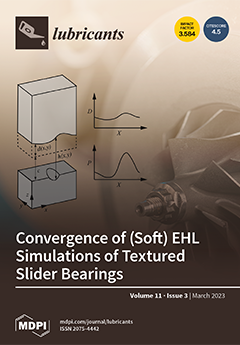In order to improve the flowabilities and anti-friction and anti-wear properties of lubricants, the viscosity variations and tribological performances of oleylamine-modified Fe
3O
4 nanoparticles as mineral oil additives were systematically investigated via rotational parallel plate rheometer, ball–disc reciprocating tribometer, non-contact three-dimensional
[...] Read more.
In order to improve the flowabilities and anti-friction and anti-wear properties of lubricants, the viscosity variations and tribological performances of oleylamine-modified Fe
3O
4 nanoparticles as mineral oil additives were systematically investigated via rotational parallel plate rheometer, ball–disc reciprocating tribometer, non-contact three-dimensional surface profiler, scanning electron microscope, energy dispersive X-ray spectrometer and X-ray photoelectron spectroscopy. Spherical monodisperse Fe
3O
4 nanoparticles were synthesized and dispersed into mineral oils to obtain lubricants with mass fractions of 1%, 3%, 5%, 8%, 10% and 20%, respectively. These lubricants have excellent stabilities within 12 months. Interestingly, the dynamic viscosity and kinematic viscosity of the lubricants first decrease and then increase with the increase in Fe
3O
4 content, and the lubricants’ viscosity is at a minimum when the mass concentration is 5%. The tensile curves also show that with the mass fraction increase, the lubricants’ tackiness and adhesion have the same change law, and both reach the lowest point when the mass concentration is 5%. Meanwhile, Fe
3O
4 nanoparticles can improve the tribological properties of the base oils. It is worth noting that the maximum reduction in the wear volume at 25 °C is up to 93.8% compared with base oils when the additive concentration of the Fe
3O
4 nanoparticles is 5 wt%.
Full article





